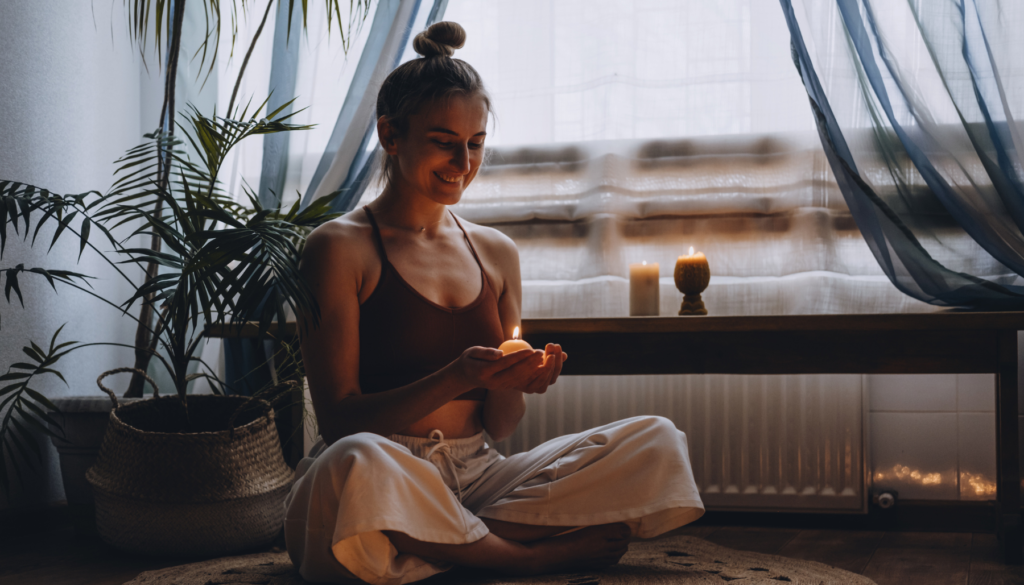Breathe in… breathe out… Breathwork is key to effective meditation, but it’s only part of this helpful practice.
Meditating should improve your life. If you’re stressed that you’re not meditating “right” or that you’re not getting enough out of your meditation practice, it could be because you haven’t found the right type of meditation for you at this time in your life.
Meditation can have a positive impact on both your mental and physical health. There’s no one perfect way to meditate – but there will probably be one type of meditation that works better for you than the others at this time in your life. Take a look at these 8 types of meditation. Which one do you think would help you the most?
Walking Meditation
You can get creative with walking meditation, but of course, you have to be walking (preferably in a park, but in a neighborhood will do just fine) to reap the benefits of this style of meditation. And you won’t just be helping your mind – you’ll be doing something good for your body, too.
Walking meditation is highly flexible. You can choose to listen to a guided meditation video or to use a meditation app while you walk. Or, choose one word or phrase to focus on during your walk. You can also aim to simply let go of all your thoughts and observe the beauty of nature around you.
Guided Meditation

Many styles of meditation involve guided meditation. In this practice, instead of allowing your mind to roam freely, you will listen as an instructor walks you through what you should be focusing on. For example, the instructor may tell you to focus on your breath or to imagine a specific scene, like a waterfall flowing over rocks.
There are multiple types of guided meditation. One type is a deep dive, which encourages you to connect with yourself as deeply as possible. Another type is a thought swap, where you try to replace one recurring thought with a healthier and more helpful one.
No matter what type of guided meditation you choose, expect to listen to someone telling you what to do. If that seems like it might be helpful, check out online resources or find out if your local yoga studio has a guided meditation class. It might be as short as 15 minutes or as long as an hour.
Sound Bath Meditation
Sound baths have existed for thousands of years. In this practice, instruments like gongs, tuning forks, chimes, percussion, and singing bowls are used to create a resonant tone. The sound bath works to change and help balance energy. There’s no melody and no recognizable pattern in a sound bath.
This type of meditation is all about creating a release; a state of harmony and relaxation. For the most effective sound bath experience, visit a yoga studio that offers sessions in person. Or, if you’re far away from yoga studios, you can try creating your own sound bath at home. Limit all your distractions and use the best audio equipment that you already have.
Chanting (Mantra) Meditation

An ancient practice, chanting meditation involves speaking a syllable, word, or phrase repeatedly. The tradition has both Buddhist and Hindu roots, but it’s also present in Judeo-Christian and Shamanic traditions.
Historically, the intention of mantra meditation was to help practitioners develop a mind-body connection that brings them closer to the divine. Nowadays, mantra meditation is used in many different contexts. It’s particularly effective in protecting your mind against fear or in fighting insomnia.
You can practice mantra meditation in a class or on your own. While you can speak a mantra from an ancient language, you don’t have to. Practice with an English language mantra instead, such as, “Inhale the future. Exhale the past.” or “Everything I need is within me.” This page lists a wide variety of mantras, from modern English to traditional Buddhist.
Transcendental Meditation
Transcendental Meditation (TM) is a very specific meditation program that was developed by Maharishi Mahesh Yogi. It can only be learned through four sessions taught by a certified TM instructor. The company compares learning meditation to learning golf or the violin – it’s much more effective when you learn from a qualified instructor.
So what exactly does this method involve? “Unlike other forms of meditation, TM practice involves no concentration, no control of the mind, no contemplation, no monitoring of thoughts. It is completely effortless.” So if you’re intimidated by the idea of meditation, this could be the right style for you.
There are many famous practitioners of TM, such as Jerry Seinfeld and Tom Brady, who have expressed that the program has helped them in their lives and careers.
Read More: Tired of Resolutions? Adopt A Word of the Year Instead
Calming Meditation

Calming meditation, or samatha meditation, encourages you to focus on the mindfulness of your breath. It is rooted in Thai Buddhist tradition and was popularized in the 1960s.
Samatha meditation helps you train your mind to develop inner strength. The focus is on creating an inner life that is free of turmoil.
In our modern lives, distraction is everywhere – and it follows us even into our most peaceful spaces. For example, say you stopped scrolling twenty minutes ago, but as you sit and attempt to practice calming meditation, your mind wanders back to what you saw on your favorite social media app.
Samatha meditation empowers you to quiet down those distractions, the chattering of your mind. It also encourages you to be kinder to yourself. One specific type of samatha is trataka meditation, which helps the practitioner to quiet their mind by focusing on a candle flame. Practicing samatha meditation is a great way to begin your meditation journey, and it’s important to practice it before trying insight meditation.
Yoga Meditation
Yoga and meditation are deeply intertwined. If you enjoy movement and are looking for physical balance as much as you seek mental balance, then yoga meditation might be the best style for you.
You don’t have to go to a class to practice yoga meditation. If you know the basics and you have space at home, you can start right away. Begin by going into cat-cow pose, and then into child’s pose. Focus on your body and your movements as you repeat this yoga flow.
You can also incorporate a guided meditation practice into your yoga movements to help you focus your mind as you calm your body.
One specific type of yoga that is tied to meditation is Kundalini yoga. This style of yoga is precise and repetitive and combines “chanting, singing, movements, and breathing in specific patterns.” It’s thought to help with stress and anxiety relief, to help sharpen the mind.
Insight Meditation

Insight meditation is a challenging type of meditation based on the practice of vipassana. According to the meditation app Headspace, vipassana meditation is “[a]nother ancient tradition, this one invites you to use your concentration to intensely examine certain aspects of your existence with the intention of eventual transformation.”
Instead of empowering you to calm your mind, insight meditation invites you to stretch yourself to reflect on your perception of both yourself and your world. It encourages you to track the experiences of your life and to pay attention to them in an open-minded way.
Insight meditation also involves inquiry. So as you take note of the events in your life, it’s important to ask questions about the what and how of these experiences. Instead of feeding into strong emotions, insight meditation encourages the practitioner to release the grip of unhelpful patterns.
Tips for Practicing Meditation at Home
Most people don’t have the time or money to go to a meditation class a couple of times a week. While you might already attend a yoga class where you practice meditation, that might not be enough. Regardless of which meditation style you think fits your life the best, it’s important to be able to practice at home.
Set aside an area of your home for meditation. It could be a corner of a bedroom or a window seat. It doesn’t need to be a large area.

Designate this as your meditation zone. Decorate the space with artwork that calms and focuses you. You could include a candle, figurines, or any other objects that make you feel at peace.
When you’re ready to meditate, let everyone you live with – whether it’s a college roommate, your romantic partner, or your teenage kids – that you are going to practice meditation and that you shouldn’t be disturbed unless it’s an emergency.
Then, put your phone far away (unless you’re using it as part of your practice). You may even want to set it on airplane mode if possible. If there’s any noise filtering into your space (like a TV or radio), go ahead and turn it off.
Choose your meditation practice based on your needs and your comfort level. Remember, by engaging in a meditation practice, you’re taking the time to do something that’s good for you.
Read More: Meditation, Anxiety, and You












